Science 101
What Cycles in the Sky Can Students Observe?
Science and Children—November/December 2020 (Volume 58, Issue 2)
By Matthew Bobrowsky
Starting in the first grade, students should be learning that the appearance of the Sun, Moon, and stars demonstrates regular patterns or cycles. They can observe daily cycles. monthly cycles, and yearly cycles.
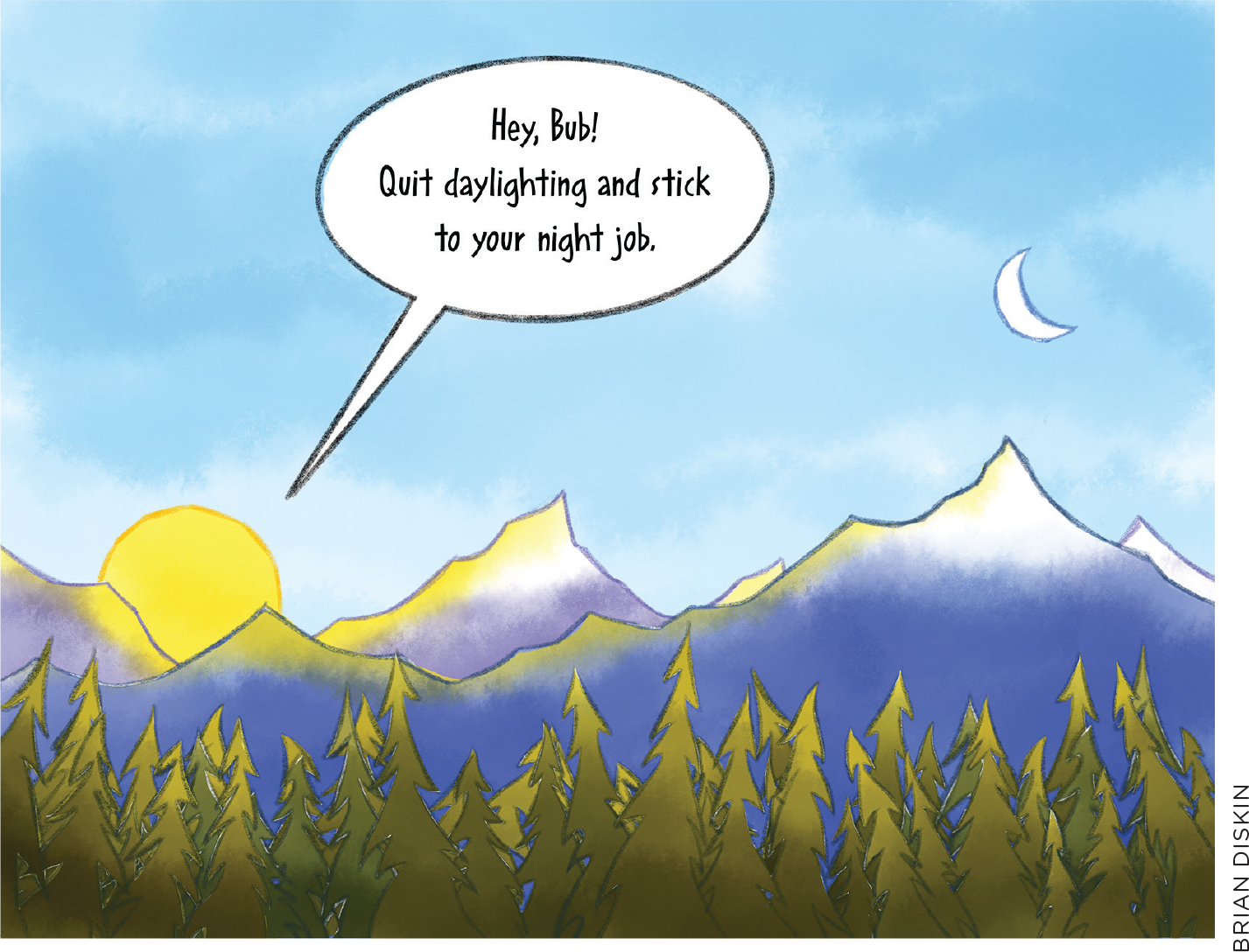
Daily Cycles
Each day, the Sun and Moon appear to rise in one part of the sky, move across the sky, and set in a different part of the sky. In the July 2019 Science 101 column, I discussed how this daily rising and setting is due to the rotation of the Earth—and included a related activity for students to do.
If the rotation of the Earth makes the Sun and Moon appear to move across the sky each day, shouldn’t it also make the stars appear to move across the sky at night? Let’s see if we can detect the movement of the stars due to the rotation of the Earth. (Students can do this at home, but try it yourself first so you can better describe the experience.) Sit outside in a chair in a location where you can see a star somewhere toward the south. It doesn’t have to be due south; southeast or southwest will be fine. Now move your chair to where the star appears barely visible just to the left of a house or building or any distant object (e.g., a chimney, telephone pole; see Figure 1). This object will serve as a position reference. If you have the star lined up just with the edge of the object, you’ll be able to make the star appear or disappear from your view just by shifting your head a bit to the right or left. You will be looking for movement of the star relative to this object. Now sit still with the star initially in view, and over the next few minutes, you’ll see that the star appears to disappear behind the object. Did the star really move behind the object? It appeared to, but, in reality, it was the Earth that moved, turning you and the object so that the star got blocked from your view.
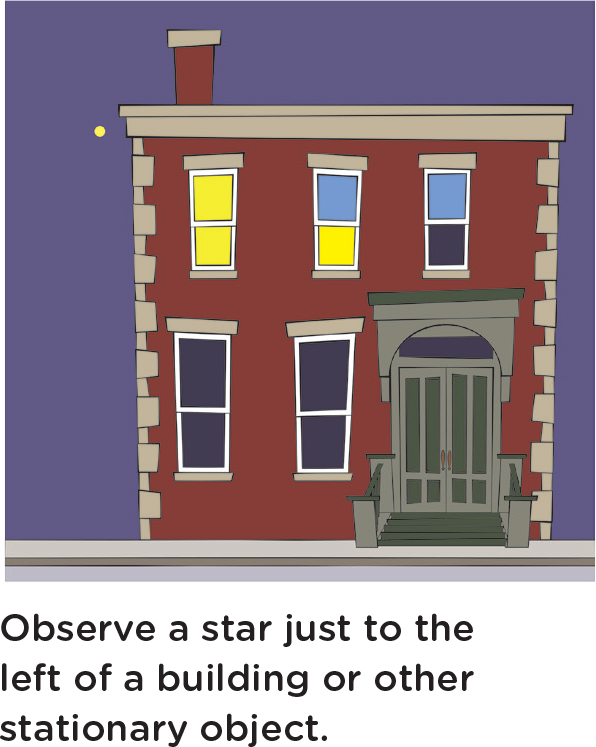
Observe a star just to the left of a building or other stationary object.
If you want to see a bigger change in a star’s position, move your chair so that a star appears just to the right of the object. In other words, the right side of the object is just about lined up with the star, but the star is barely visible on the right side (see Figure 2). Now leave your chair there and go back inside and do something for about 30 or 40 minutes. Maybe read some more of Science and Children! After the 30–40 minutes, go back out and sit in your chair. Where is the star now? You should see it noticeably farther to the right, i.e., farther toward the west! The longer you wait, the more the star will appear to have moved—due to the Earth’s rotation.
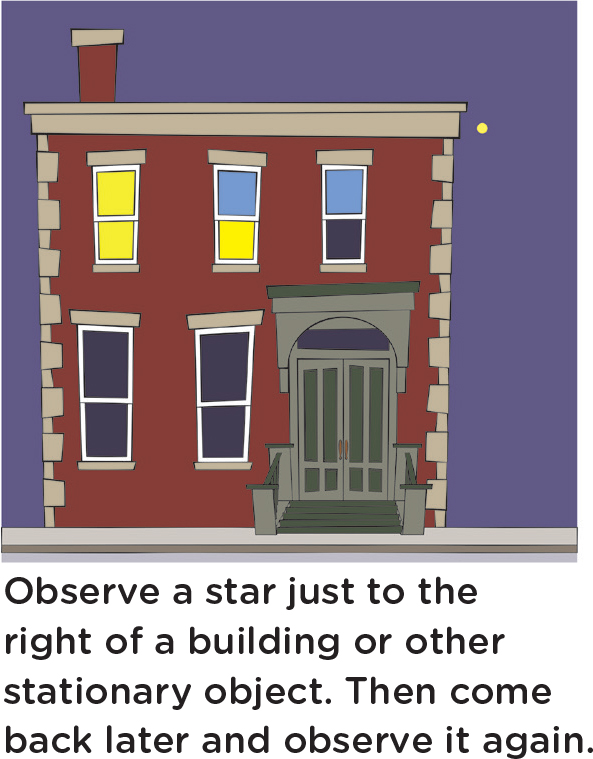
Observe a star just to the right of a building or other stationary object. Then come back later and observe it again.
If you were to wait approximately 24 hours, the Earth would rotate you completely around, and you’d again be seeing the star in the same direction as the day before. And if you had sat in that chair for those 24 hours, what would you have seen the star do? In principle, you would have seen the star move across the sky, set in the west, eventually rise in the east, and gradually move back to its previous position to the right of your reference object. In reality you would lose sight of the star once the Sun comes up and the sky gets bright.
You can do the same activity using the Moon instead of a star. If you use the Moon, then it’s possible to do the activity during the day—provided that the Moon is visible in the sky. When the Moon is at first-quarter phase, it’s typically visible in the southeast in the late afternoon. Appearing significantly bigger in the sky than a star, the Moon would take longer to disappear behind a building. You might have to wait 10 minutes or so.
Monthly Cycles
What’s a monthly cycle that we observe (in the sky)? The Moon exhibits two types of cycles, each with a period of 29.5 days, or about a month. One cycle is the Moon going through its phases. I have my students observe the phase of the Moon on each clear evening over a two-week period starting two days after new Moon. This allows them to see the Moon gradually change from a crescent to first quarter (when it looks half-full), to gibbous (more than half full but not completely full), and then full. Twenty-nine or 30 days after they start, they can see that the Moon has returned to being a crescent again. Figure 3 shows these phases (but not the complete set of phases, as we’re talking about observations over only half of the complete lunar cycle).

The phases of the Moon that you can see during the day for two weeks following a New Moon.
Misconception Alert 1
Many people—both adults and children who have been told this by adults—think that the Moon is visible only at night. It’s understandable how people might get this idea, since the Moon is much less noticeable during the day and is clearly evident in the sky at night. In fact, the Moon is visible during the daytime just as often as it’s visible at night.
The other lunar cycle students can observe is how, observing at the same time each evening, the Moon appears to change its position in the sky. When they first observe the crescent Moon in the early evening, it’s in the west. Over the course of the two weeks, the Moon appears to gradually move farther toward the east. Ask students why the Moon appears in a position farther toward the east each successive night at the same time. A common incorrect answer is that it’s because of the Earth’s rotation. But consider: If you’re observing at the same time each night, then the Earth has made one complete turn since the previous night, and you’re back to where you started. So that wouldn’t cause the Moon to appear in a different place. But what else is moving? The Moon! The Moon is in orbit around the Earth, and as it moves in its orbit, we see it at different locations in the sky. Students can make charts and drawings of their observations of these two monthly cycles.
Annual Cycles
Ask students what yearly cycles they can think of. Depending on the grade, you’ll want to phrase this differently, but the point is to ask what is changing over the course of the year and then gets back to pretty much the same a year later. One of these annual cycles is the seasons. Ask: Why does the cycle of the seasons last one year? Any annual cycle in the sky has something to do with the Earth’s orbit around the Sun—a trip that takes one year. During that yearly voyage, we observe several cycles. Besides the seasons, we see that different constellations are visible at different times of the year, as the nighttime side of the Earth faces different directions in space. The summer constellations (like Scorpius) are different from the winter constellations (like Orion; see Figure 4). Use planetarium software like Stellarium (see Internet Resources) to find out what constellations are visible at any time on any date.
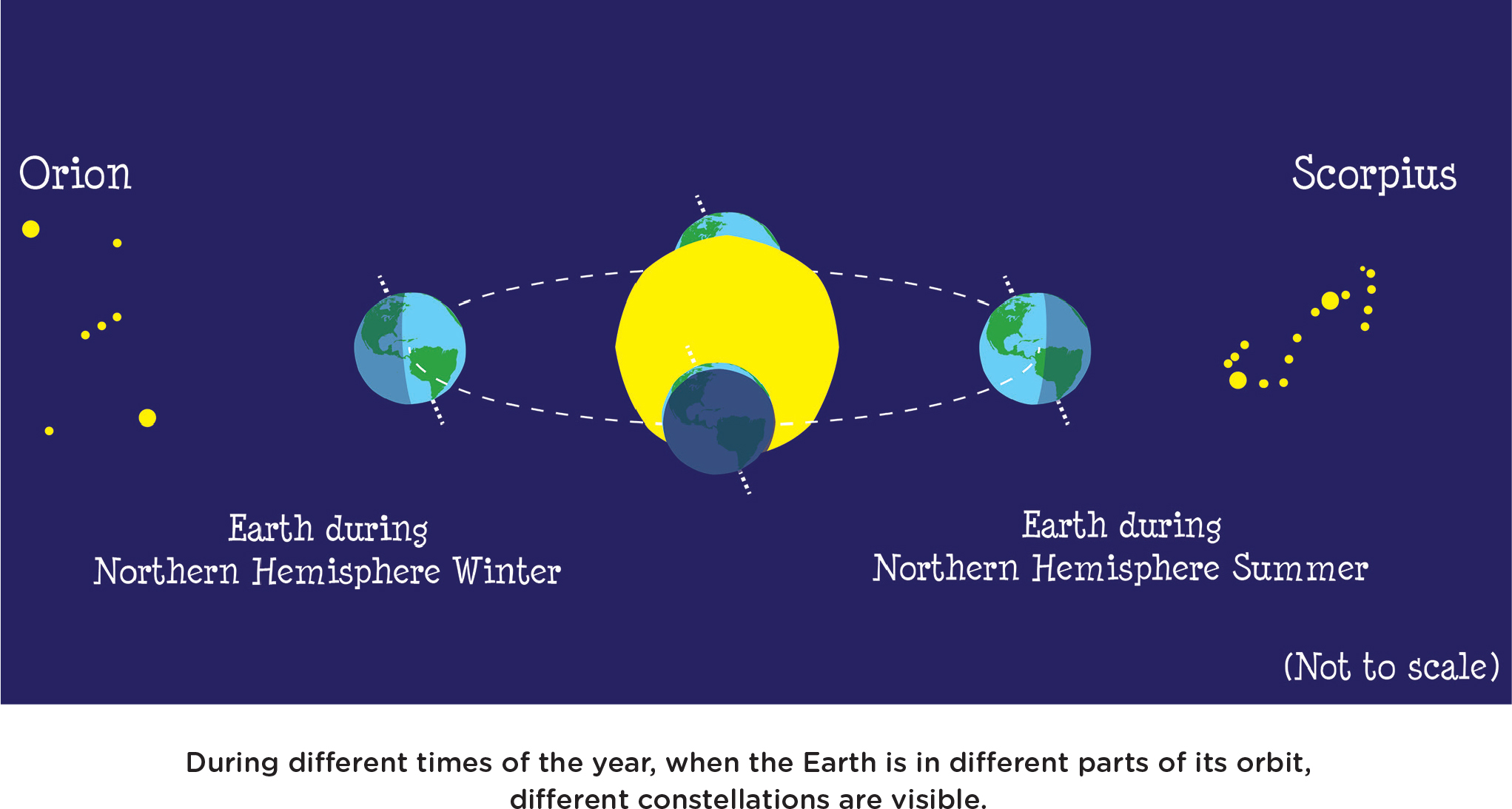
During different times of the year, when the Earth is in different parts of its orbit, different constellations are visible.
Other annual cycles are related to where you see the Sun in the sky. In the summer, the Sun rises in the northeast, rises very high in the sky (in the south), and sets in the northwest (see Figure 5). In the winter, the Sun rises in the southeast, doesn’t get very high in the sky (at its highest point in the south), and sets in the southwest. What I’ve described is correct for viewing from intermediate northern latitudes, e.g., from the continental United States. Over the course of a few months, students can track these cycles. For example, they can observe where the Sun appears to set as seen from a particular spot, perhaps in front of their homes. They can draw the setting position relative to houses, trees, or other reference objects. Over a few months, they’ll see a change in where they mark the position of sunset.
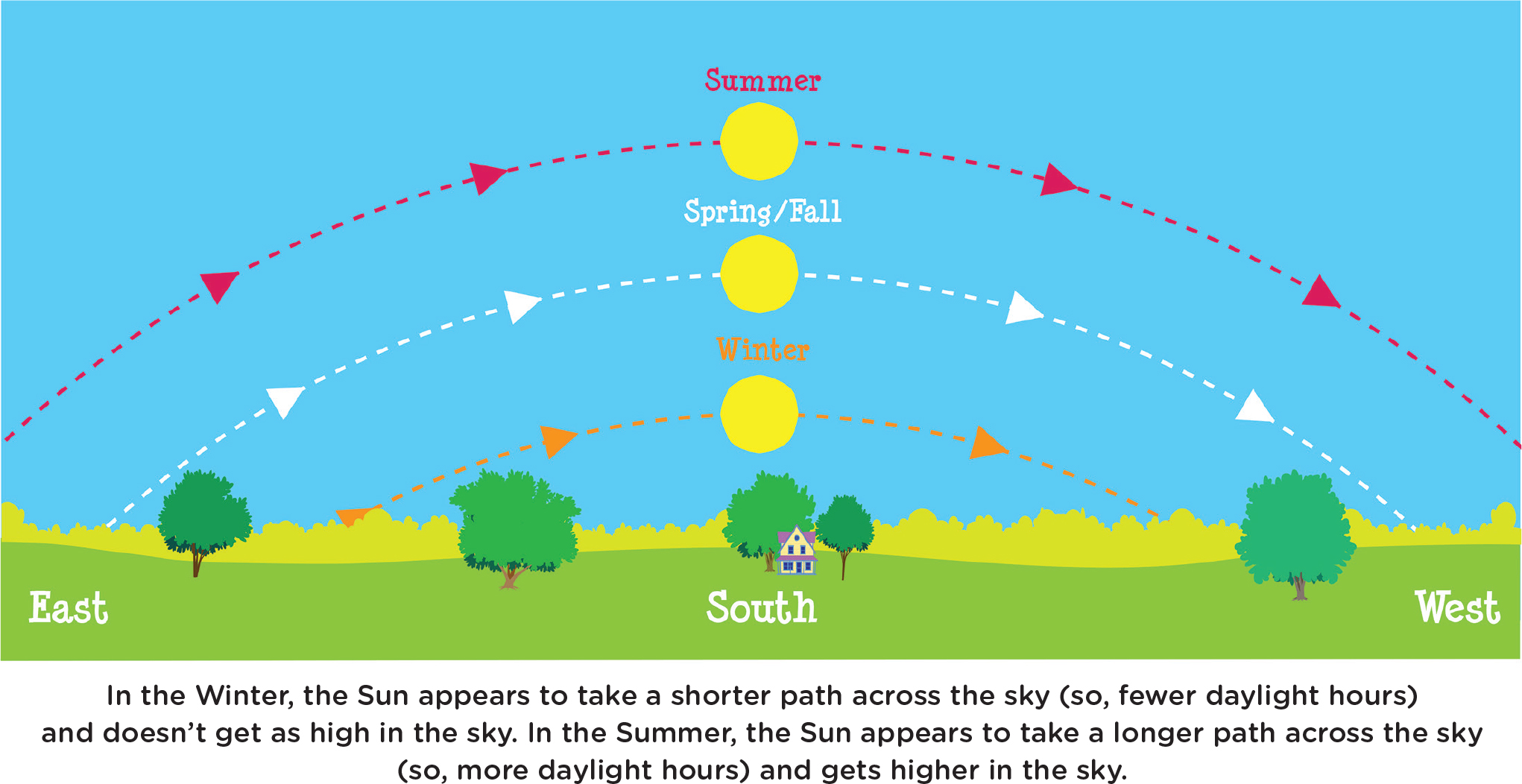
In the Winter, the Sun appears to take a shorter path across the sky (so, fewer daylight hours) and doesn’t get as high in the sky. In the Summer, the Sun appears to take a longer path across the sky (so, more daylight hours) and gets higher in the sky.
Misconception Alert 2
While many students enter the classroom with the misconception that the Earth is closer to the Sun in summer (it isn’t), it turns out that many teachers inadvertently replace that idea with another misconception—that the seasons arise because the tilt of the Earth makes one hemisphere closer to the Sun than the other. The tilt of the Earth is important, but for reasons that have nothing to do with the distance from the Sun. When the Northern Hemisphere is tilted toward the Sun, and we experience summer, it’s warmer because sunlight hits the Earth from a higher angle (making the light more concentrated) and because there are more hours of daylight each day. In fact, both the northern and southern hemispheres of Earth are farthest from the Sun during the northern hemisphere summer.
We’ve seen that, due to the motions of the Earth and Moon, students can observe daily, monthly, and yearly cycles. Have the students caught on to the fact that these cycles were the basis for some units of time that we use—the day, month, and year—all based on the motions of objects in space? (The Earth is also an object in space.) For millennia, people have used these astronomical cycles as calendars. Ancient Egyptians used the annual appearance of the star Sirius to predict the flooding of the Nile river. You can read more about ancient timekeeping in the article linked in the Internet Resources. Finally, for a long time, the time of day was determined by the Sun’s position in the sky, as shown on a sundial. Our current timekeeping is still kept roughly in sync with the Sun. And now my time is up, so I’ll have to stop.
Never stop learning.
Internet Resources
Stellarium free planetarium software for your computer
Matt Bobrowsky is the lead author of the NSTA Press book series, Phenomenon-Based Learning: Using Physical Science Gadgets & Gizmos. You can let him know if there’s a science concept that you would like to hear more about. Contact him at: DrMatt@msb-science.com
Earth & Space Science Environmental Science Teaching Strategies Elementary


